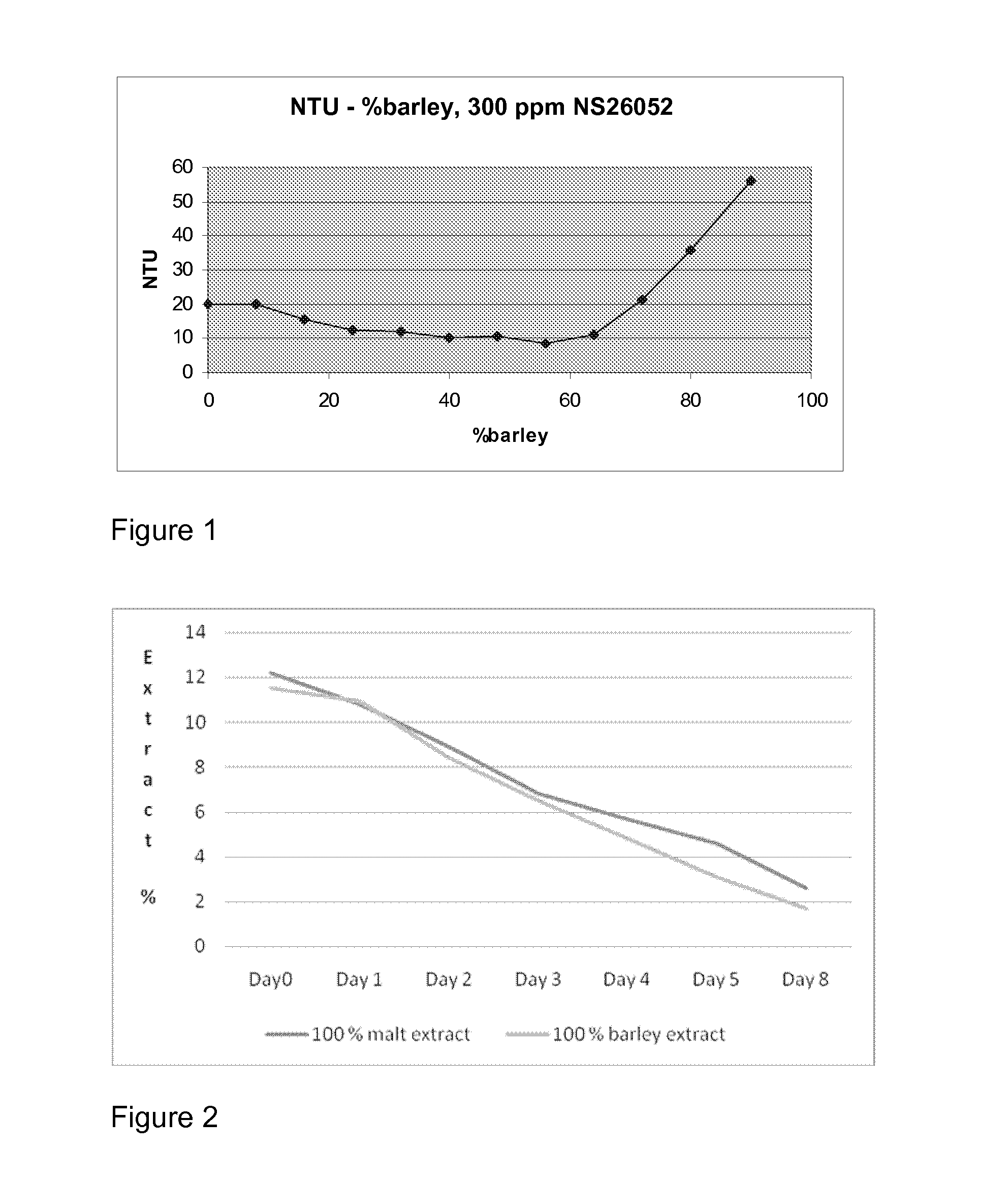Brewing Process
a technology of brewing process and mash/wort, which is applied in the field of brewing process, can solve the problems of increased mash/wort viscosity, difficulty in lautering, and energy and time-consuming and thus rather costly malting process, and achieve the effect of less viscosity
- Summary
- Abstract
- Description
- Claims
- Application Information
AI Technical Summary
Benefits of technology
Problems solved by technology
Method used
Image
Examples
example 1
[0196]The purpose of this example was to select the best suitable pullulanase for the production of wort based on RDF and DP2 (maltose). A grist comprising 100% unmalted barley was prepared as described above.
[0197]All cups were then added 50 ppm Na2SO3 and the enzymes:
[0198]α-amylase (Termamyl SC): 0.3 KNU(S) / g,
[0199]β-glucanase and xylanase (Ultraflo Max / Viscoflow XL): 300 ppm,
[0200]Protease (Neutrase 0.8) 0.002 AU / g,
[0201]Flavourzyme™ 1000 L: 0.1 LAPU / g, and
[0202]Pullulanase as described in Table 2:
[0203]The mashing was performed and the cups were added city water to a total of 300 g after mashing. The mash was filtered, and the results in Table 1 below were obtained by analyzing the wort:
TABLE 1100% barley: RDF, % and wort sugar.Enzyme dosageDP2DP4+PUN / g% of total% of totalRDF %—0.0048.733.262.0Promozyme0.149.431.664.0Promozyme0.249.730.665.0Promozyme0.350.3*29.6*65.8*Promozyme0.551.627.667.0—0.0048.733.262.0NS260620.150.030.264.6NS260620.250.828.466.1NS260620.351.3*27.3*67.3*NS...
example 2
[0205]The following example demonstrates the different temperature optimum and the relative activity at different temperatures. The relative enzyme activity of three different pullulanases was analysed. The method of analyzing pullulanase activity is by detection of increased reducing sugar capacity (Somogyi-Nelson reacition) in the following conditions:
[0206]Substrate: 0.2% pullulan, pH 5.0, reaction time 30 minutes, stop of enzyme reaction by adding Somogyi copper reagent, followed by Nelson color reagent and boiling in 20 minutes. Samples were incubated at 30° C., 45° C., 55° C., 60° C., 62.5° C., 65° C., and 70° C. in 30 minutes. The samples were analyzed by spectrophotometer at OD520 nm, and the difference between sample and blank (increased by enzyme activity) were used in calculation of the results.
[0207]The highest activity was set to 100% (maximum) and activities at other temperatures set relative to the temperature maximum.
TABLE 2Relative activity of different pullulanases...
example 3
[0209]The purpose of this experiment was to evaluate the effective dosage enzyme protein (EP) per g dm (gram dry matter) of 3 of different pullulanases (NS26062 / PulC, Promozyme 400 L and Promozyme D2 (Optimax 1000 L) in saccharification of either 100% unmalted barley or 100% malted barley when applied in infusion mashing for 2 hours.
[0210]All cups were added enzymes blend 2 kg / 1000 kg barley:
[0211]α-amylase (Termamyl SC) 0.3 KNU(S) / g,
[0212]β-glucanase and xylanase (Ultraflo MaxNiscoflow XL) 300 ppm,
[0213]Protease (Neutrase) 0.001 AU / g,
[0214]Lipase (Lipozyme TL 20 LU / g)
[0215]Different pullulanases dosages were added.
[0216]Specific activity:
[0217]NS26062: 57 PUN / mg EP.
[0218]Promozyme 400 L: 136 PUN / mg EP
[0219]Promozyme D2: 236 NPUN / mg EP
[0220]Iso-amylase from Hayashibara Co Ltd: Specific activity unknown
[0221]The specific activities were measured after the pullulanases were purified by standard chromatographic techniques
[0222]Mashing conditions: 54° C. in 30 minutes, increase to 64° C...
PUM
| Property | Measurement | Unit |
|---|---|---|
| wt % | aaaaa | aaaaa |
| temperature | aaaaa | aaaaa |
| temperature | aaaaa | aaaaa |
Abstract
Description
Claims
Application Information
 Login to View More
Login to View More - R&D
- Intellectual Property
- Life Sciences
- Materials
- Tech Scout
- Unparalleled Data Quality
- Higher Quality Content
- 60% Fewer Hallucinations
Browse by: Latest US Patents, China's latest patents, Technical Efficacy Thesaurus, Application Domain, Technology Topic, Popular Technical Reports.
© 2025 PatSnap. All rights reserved.Legal|Privacy policy|Modern Slavery Act Transparency Statement|Sitemap|About US| Contact US: help@patsnap.com

